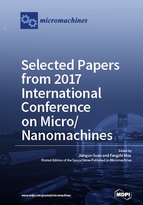Selected Papers from 2017 International Conference on Micro/Nanomachines
A special issue of Micromachines (ISSN 2072-666X).
Deadline for manuscript submissions: closed (1 January 2018) | Viewed by 71999
Special Issue Editors
Interests: functional composite materials; metamaterials; micro-/nanorobots; photonic crystals
Special Issues, Collections and Topics in MDPI journals
Interests: micro-/nanorobots; responsive photonics; biomedical applications
Special Issues, Collections and Topics in MDPI journals
Special Issue Information
Dear Colleagues,
The 2017 International Conference on Micro/Nanomachines (http://www.icmnm.org/) is to be held in Wuhan, China, 25-28 August, 2017. Micro/nanomotors (MNMs), which are defined as micro/nanodevices capable of converting various energy into autonomous motion, can be used to pick up, transport, and release various cargoes within a liquid medium. They have important potential applications, for example, in drug delivery, biosensors, protein and cell separation, microsurgeries, and environment remediation. MNMs can be classified into two categories according to propulsion mechanism, self-propelled MNMs are capable of moving autonomously without external intervention, but they either require toxic fuel or have a short lifespan. MNMs actuated by external fields, such as light, magnetic field and acoustic waves, are not subject to these problems, there are no toxic fuels or by-products involved during the motion process. For both self-propelled and field-actuated MNMs, there is still a long way to go before we reach practical applications. The future development of MNMs should be focused on improving energy conversion efficiency through optimization of structures, exploring new propulsion mechanisms and endowing MNMs with environmental responses for self-navigation, detection, and specific operations. In this way, MNMs will approach to the practical applications in biomedicine, environment treatment, microengineering, etc.
Prof. Dr. Jianguo Guan,
Dr. Fangzhi Mou
Guest Editors
Manuscript Submission Information
Manuscripts should be submitted online at www.mdpi.com by registering and logging in to this website. Once you are registered, click here to go to the submission form. Manuscripts can be submitted until the deadline. All submissions that pass pre-check are peer-reviewed. Accepted papers will be published continuously in the journal (as soon as accepted) and will be listed together on the special issue website. Research articles, review articles as well as short communications are invited. For planned papers, a title and short abstract (about 100 words) can be sent to the Editorial Office for announcement on this website.
Submitted manuscripts should not have been published previously, nor be under consideration for publication elsewhere (except conference proceedings papers). All manuscripts are thoroughly refereed through a single-blind peer-review process. A guide for authors and other relevant information for submission of manuscripts is available on the Instructions for Authors page. Micromachines is an international peer-reviewed open access monthly journal published by MDPI.
Please visit the Instructions for Authors page before submitting a manuscript. The Article Processing Charge (APC) for publication in this open access journal is 2600 CHF (Swiss Francs). Submitted papers should be well formatted and use good English. Authors may use MDPI's English editing service prior to publication or during author revisions.
Keywords
-
Micro/Nanomachines
-
Autonomous motion
-
Drug delivery
-
Environmental remediation
-
Self-navigation
-
Microengineering








